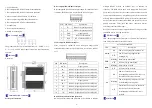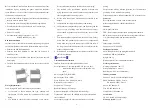
- 3 -
Before installation, confirm that the work environment meet the
installation require, including the power needs and abundant
space. Whether it is close to the connection equipment and other
equipments are prepared or not.
1. Avoid in the sunshine, keep away from the heat fountainhead or
the area where in intense EMI.
2. Examine the cables and plugs that installation requirements.
3. Examine whether the cables be seemly or not according to
reasonable scheme.
4. Power: 12 ~ 48VDC
5. Environment: Working Temperature: -40
~
75
℃
Relative humidity 5%
~
95%
DIN Rail Installation
In order to use in industrial environments expediently, the product
adopt 35mm DIN-Rail installation, the installation steps as below:
1.
Examine the DIN-Rail attachment
2.
Examine DIN Rail whether be firm and the position is
suitability or not.
3.
Insert the top of the DIN-Rail into the slot just below the stiff
metal spring.
4.
The DIN-Rail attachment unit will snap into place as shown
below.
Wiring Requirements
Cable laying need to meet the following requirements,
1.
It is needed to check whether the type, quantity and
specification of cable match the requirement before cable
laying;
2.
It is needed to check the cable is damaged or not, factory
records and quality assurance booklet before cable laying;
3.
The required cable specification, quantity, direction and
laying position need to match construction requirements, and
cable length depends on actual position;
4.
All the cable cannot have break-down and terminal in the
middle;
5.
Cables should be straight in the hallways and turning;
6.
Cable should be straight in the groove, and cannot beyond the
groove in case of holding back the inlet and outlet holes.
Cables should be banded and fixed when they are out of the
groove;
7.
User cable should be separated from the power lines. Cables,
power lines and grounding lines cannot be overlapped and
mixed when they are in the same groove road. When cable is
too long, it cannot hold down other cable, but structure in the
middle of alignment rack;
8.
It should have corresponding simple signal at both sides of the
cable for maintaining.
【
Specification
】
Communication Parameters
Interface Protocol: compliant with EIARS-232/485
Serial port number: 1 host computer RS-232 port or 1 host
computer RS-485 port, 4 slave computer RS-485
ports
RS-232 signal: TxD, RxD, GND
RS-485 signal: D+, D-, GND
Parity bit: None, Even, Odd, Space, Mark
Data bit: 5bit, 6bit, 7bit, 8bit
Stop bit: 1bit, 1.5bit, 2bit
Baud rate: 300bps~115200bps
Direction control: RS-485 adopts ADDC technology
Transmission media: CAT.5E shielded twisted pair or dedicated
line for RS-485
Load capacity: support 32 nodes (customizable to 128 nodes)
polling
Port protection: 2KVAC isolation protection, level-4 electrostatic
protection, level-2 radiated susceptibility
Transmission distance: RS-485 1200m, RS-232 is less than 15m
Connector
Host computer RS-232/485: 5PIN terminal blocks
Slave computer RS-485: 10PIN terminal blocks
Indicator
PWR: power indicator
TXD: Host computer serial port data sending status indicator
RXD: Host computer serial port data receiving status indicator
1~4: Slave computer RS-485 port status indicator
Power
Input voltage: 12-48VDC
Load power: 0.7W@24VDC
Mechanical structure
Shell: IP40 protection, high-strength metal shell
Installation: DIN-rail installation
Weight: 384.8g
Dimension (L*W*H): 110mm*95mm*35mm
Working environment
Working temperature: -40~75
℃
Storage temperature: -40~85
℃
Humidity: 5%~95% (no condensation)
Industry standard
EMI: FCC Part 15, CISPR (EN55022) class A
EMS: EN61000-4-2 (ESD), Level 4
EN61000-4-3 (RS), Level 2
Shock : IEC 60068-2-27
Free fall: IEC 60068-2-32
Vibration test: IEC 60068-2-6
Certification:
CE, FCC, RoHS, UL508 (pending)
Warranty period:
3 years





















